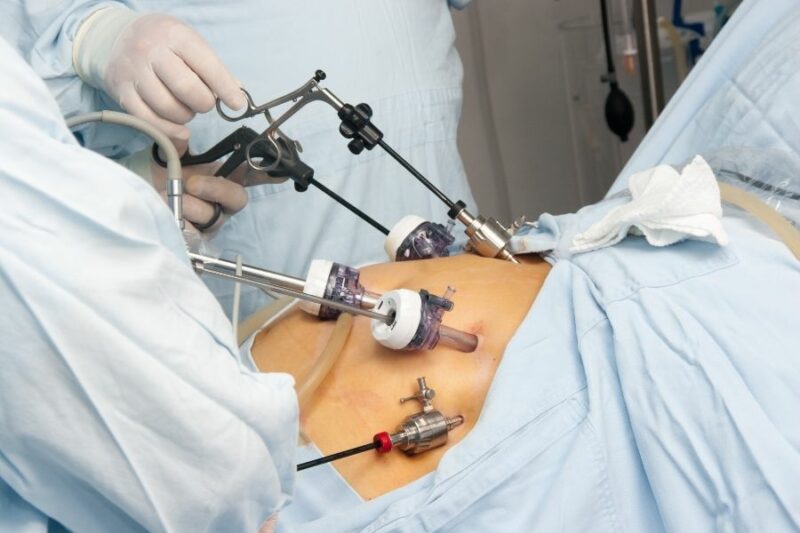Uterine Fibroids
Uterine fibroids are the most prevalent benign tumors of the pelvic region among women.1,2 These fibroids are responsible for nearly 30% of the gynecological hospitalizations among women of reproductive age.1
Surgical procedures like hysterectomy, myomectomy, and uterine artery embolization are commonly recommended for uterine fibroids.2 More recently, the use of less invasive treatment approaches like Acessa™ fibroid ablation is also increasing.3,4 In this article, we discuss Acessa fibroid ablation, its risks, limitations and cost, and why it may not work for some patients.
Acessa Fibroid Ablation
Acessa fibroid ablation, also known as radiofrequency ablation, is a treatment that uses heat energy to treat fibroids. To visualize the fibroids this requires incisions on the abdomen to place instruments into the pelvis. One instrument is an ultrasound to see the deeper fibroids, while another is a large needle that is advanced into the fibroids to burn the tissues.3,4 The needle uses a radiofrequency current to create heat energy that destroys the targeted tissues, the fibroids are not removed.4 This procedure is less invasive than hysterectomy and can be effective in the right candidate.4 Because the procedure is painful, this needs to be done under general anesthesia.
Acessa Fibroid Ablation: Ideal Candidate
Women with fibroid symptoms who have normal blood clotting, hemoglobin levels over 10 g/dL, and a small fibroid volume are good candidates for Acessa fibroid ablation.5 However, those with numerous, connected, pedunculated, subserosal or intracavitary fibroids are not good candidates for this procedure.5
Also, this is not the recommended treatment for women looking to have future children as there is not enough data to know how this affects fertility.
Acessa Fibroid Ablation: Risks
Only about 4% of the patients who undergo Acessa fibroid ablation report adverse events.3
These adverse events include laceration of internal tissues (e.g. bowel perforation) due to the probes and needles inserted, vaginal bleeding, post-procedural pelvic abscess, chronic pain in the lower abdomen, and superficial burns in the uterus.3,6,7 There is also possibility of forming intrauterine adhesion after Acessa fibroid ablation resulting in future bowel obstruction.4
Symptoms may persist in those that were not good candidates. After fibroid ablation the surrounding myometrium slowly resorbs the fibroid, however this may not occur for large fibroids.4
Acessa Fibroid Ablation: Limitations
Acessa fibroid ablation is associated with some limitations, including those related to surgeon experience and expertise. The surgeons conducting Acessa fibroid ablation must be trained in performing laparoscopic surgeries and conducting and interpreting pelvic ultrasound.4 Without adequate operator experience the probes and needles could lacerate bowel, bladder, liver and other organs nearby. Also excessive intra-abdominal bleeding will lead to adhesions that can result in bowel being twisted together.
If the operator is not adequately trained in ultrasound guided experience, they could potentially miss the fibroid or burn tissues outside of the fibroid, such as the normal uterine tissue. If the burn zone extends towards outside of the uterus this could result in a superficial burn of the outer layer leaving chronic deformity and scarring of the uterus. If the burn zone extends into the inner layer this will result in non-viable chronic scarring of the endometrial lining, which would affect future fertility.
Those with limited experience must restrict the number, size, and volume of the fibroids they treat with Acessa fibroid ablation.4 For example, mid-level surgeons can generally only handle 1-3 fibroids per procedure.4 This would not be ideal for someone that has numerous fibroids due the repeated procedures and cost.
Acessa fibroid ablation also cannot treat fibroids in certain high-risk locations, such as cervix, areas outside the uterus such as along the broad and round ligament.4 If a surgeon attempts to burn fibroids in high-risk areas this could risk burning the fallopian tubes, ovaries or ureters that carry urine. Furthermore, fibroids that are entirely intracavitary cannot be treated through Acessa fibroid ablation.4 Someone that has numerous fibroids can have less than satisfactory result as only some of the fibroids can be treated in one setting, resulting in recurrent or persistent symptoms.
Since the procedure is surgical in nature, this also must be performed at a hospital or surgical center that has all the necessary equipment and general anesthesia.4
Acessa Fibroid Ablation: Fertility
Acessa Fibroid Ablation: Cost
This procedure only received FDA approval in 2012 and has not been long studied, and as a result it is not covered by insurance.3,8 Acessa fibroid ablation has an out of pocket cost of over $15,000, depending on geographic and case-to-case variations.8
Acessa Fibroid Ablation: Why it did not Work
There could various reasons why Acessa fibroid ablation did not work for you. Nearly 11% of the patients who undergo Acessa™ fibroid ablation require re-intervention for their fibroid symptoms.4
If you have completely intracavitary fibroids, the ablation may have been unable to treat them and your symptoms may return.4 Hysteroscopic resection would have been a better alternative.
If you have numerous fibroids, some of the fibroids may have been left untreated. Uterine artery embolization is a better treatment option as it can target all of the fibroids in one treatment.
If your fibroid was in a location that could not be accessed by the needle or visualized by the ultrasound, then your symptoms could persist or recur.
The competence and experience of the surgeon could have significantly impacted the success of your procedure.4 If they do not properly visualize the deeper fibroids or appropriately place the probe by ultrasound this could result in under-treatment.
If your fibroid was too large the ablation may have limited results as it is unable to provide a large enough burn zone to cause adequate shrinkage.
Acessa fibroid ablation is a relatively new minimally invasive approach to treat uterine fibroids and requires longer study. If you are a patient seeking this procedure, discuss the limitations and risks with your doctor.
Uterine Fibroid Embolization (UFE) vs. Acessa Fibroid Ablation
UFE and Acessa are both treatment options that can prevent women from losing their uterus, and are alternatives to myomectomy and hysterectomy.
UFE, unlike Acessa, is a non-surgical procedure that can treat all of the fibroids at once using a small vessel in the arm or leg. All fibroids can be targeted in one session irrespective of the size or number. It is performed by targeting the blood vessels that nourish the fibroids. Once these vessels are blocked, the fibroids shrink and die. This does not require any cutting or burning, which can violate the uterine tissue. The UFE procedure is performed by our highly trained and experienced Interventional Radiologist who is an image-guided specialist.
Because Acessa is a more invasive surgery that has to burn each fibroid, this surgery can take up to two hours or longer, and must be performed with general anesthesia due to the pain caused by burning tissues. UFE, on the other hand, only requires local and mild sedation, which does not require intubation and avoids general anesthesia risks.
UFE is a quick and safe outpatient procedure that has a faster recovery. Patients are likely to opt for UFE because it is less invasive, has minimal risks, and a faster recovery.
Some of the UFE advantages include:
- No hospital stay
- No general anesthesia
- No stitches
- No blood loss
- No risk of hysterectomy
- No major scars
- No surgical risks
Read more about the Advantages of UFE (click here)
We are Here to Help
Request an appointment to meet with our fibroid specialist who will review your imaging, labs and history to determine if you are candidate for the procedure, and the outcomes you can expect. Each woman is an individual and should discuss the potential risks and benefits of fibroid embolization and other treatments with our doctor to decide which option is best for her.
Appointments are available via an online video telehealth platform or in person at one of the offices in Los Angeles, Orange County or San Diego. Why should you choose us? Read here.
- Pavone, D., Clemenza, S., Sorbi, F., Fambrini, M. and Petraglia, F., 2018. Epidemiology and risk factors of uterine fibroids. Best Practice & Research Clinical Obstetrics & Gynaecology, 46, pp.3-11.
- De La Cruz, M.S.D. and Buchanan, E.M., 2017. Uterine fibroids: diagnosis and treatment. American Family Physician, 95(2), pp.100-107.
- Lee, B.B., Isaacson, K.B. and Diamond, M.P., 2015. Radiofrequency volumetric thermal ablation of symptomatic uterine fibroids: the Acessa procedure. Etiology, Clinical Manifestations, Evaluation and Management of Uterine Leiomyoma. New York, NY, USA: Nova Science Publishers, pp.175-193.
- Lee, B.B. and Yu, S.P., 2016. Radiofrequency ablation of uterine fibroids: a review. Current obstetrics and gynecology reports, 5(4), pp.318-324.
- Guido, R.S., Macer, J.A., Abbott, K., Falls, J.L., Tilley, I.B. and Chudnoff, S.G., 2013. Radiofrequency volumetric thermal ablation of fibroids: a prospective, clinical analysis of two years’ outcome from the Halt trial. Health and quality of life outcomes, 11(1), pp.1-8.
- Braun, K.M., Sheridan, M., Latif, E.Z., Regush, L., Maksymowicz, A., Weins, L., Bedaiwy, M.A., Tyson, N., Davidson, M.J. and Sanders, B.H., 2016. surgeons’ early experience with the acessa™ procedure: gaining proficiency with new technology. International Journal of Women’s Health, 8, p.669.
- Lin, E., Sendukas, E. and Kho, K.A., 2022. Post-Operative Uterine Necrosis and Peritonitis Following Laparoscopic Radiofrequency Fibroid Ablation. Journal of Minimally Invasive Gynecology.
- https://www.usafibroidcenters.com/uterine-fibroid-treatment/acessa-procedure-vs-ufe/







